Abdollah Masoud Darya
EM-Based Channel Estimation for mMIMO LEO SATCOM Under Imperfect Doppler Compensation
May 20, 2025Abstract:Massive multiple-input multiple-output low-Earth-orbit communication channels are highly time-varying due to severe Doppler shifts and propagation delays. While satellite-mobility-induced Doppler shifts can be compensated using known ephemeris data, those caused by user mobility require accurate user positioning information; the absence of such information contributes to amplified channel aging in conventional channel estimators. To address this challenge, we propose a data-aided channel estimator based on the expectation-maximization (EM) algorithm, combined with a discrete Legendre polynomial basis expansion method (DLP-BEM), to estimate the channel under imperfect Doppler compensation. The EM algorithm iteratively exploits hidden data symbols for improved channel estimation, while DLP-BEM regularizes the process by projecting the channel estimate onto a lower dimensional subspace that mitigates estimation errors. Simulation results demonstrate the superiority of the proposed framework over existing methods in terms of normalized mean square error and symbol error rate.
Semi-blind Channel Estimation for Massive MIMO LEO Satellite Communications
Nov 21, 2024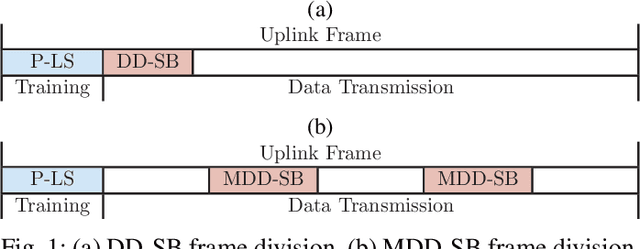
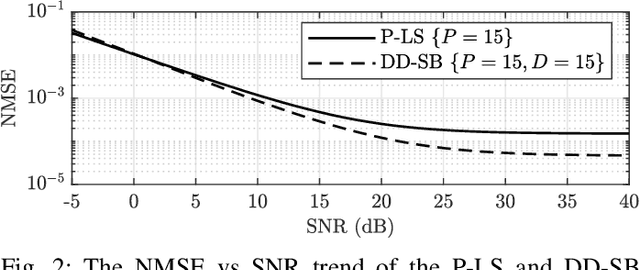
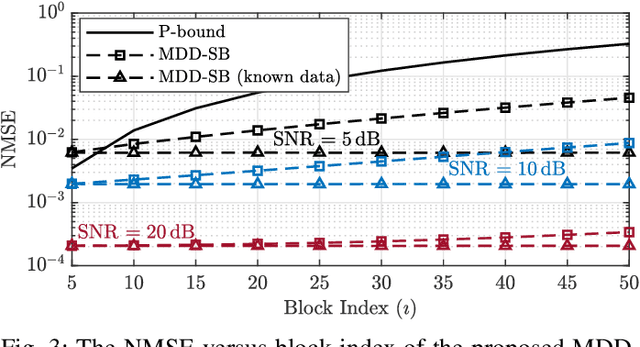
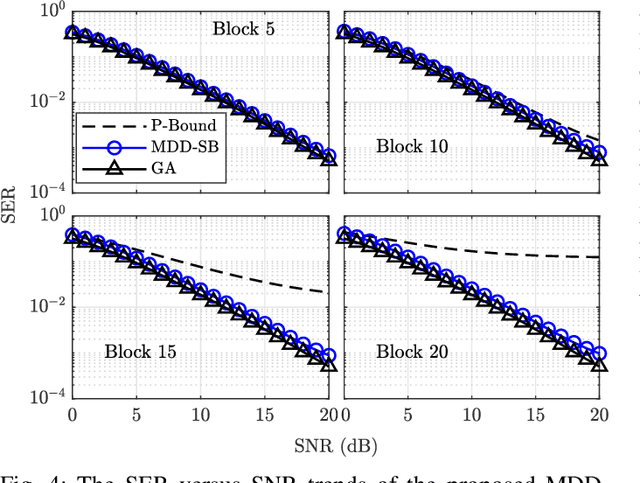
Abstract:This letter proposes decision-directed semi-blind channel estimation for massive multiple-input multiple-output low-Earth-orbit satellite communications. Two semi-blind estimators are proposed. The first utilizes detected data symbols in addition to pilot symbols. The second, a modified semi-blind estimator, is specially designed to mitigate the channel-aging effect caused by the highly dynamic nature of low-Earth-orbit satellite communication channels -- an issue that adversely impacts the performance of pilot-based estimators. Consequently, this modified estimator outperforms an optimal pilot-based estimator in terms of normalized mean square error and achieves symbol error rate performance comparable to that of a Genie-aided (perfectly known channel) detector. The trade-offs between the proposed estimators are also examined.
Multi-instrument analysis of L-band amplitude scintillation observed over the Eastern Arabian Peninsula
May 23, 2024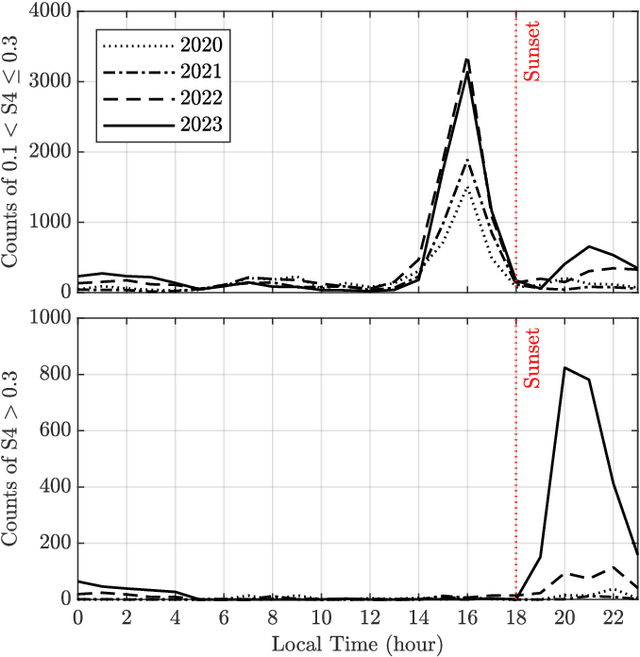
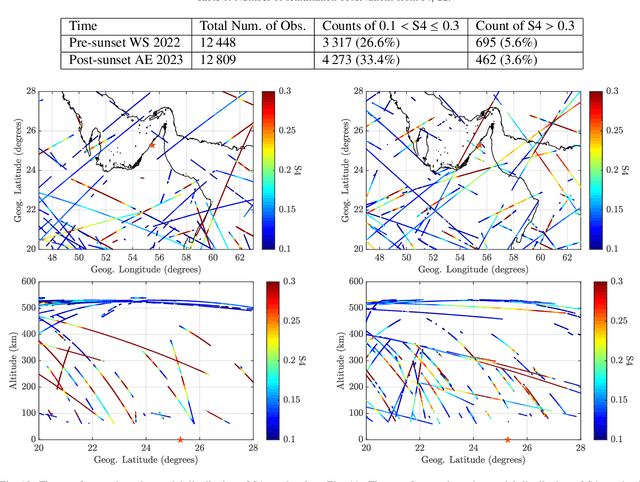
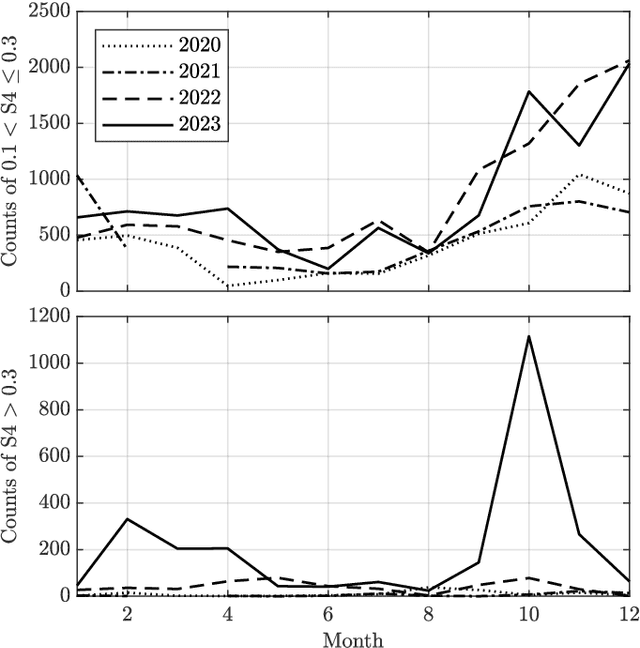

Abstract:This study investigates the spatial and temporal characteristics of L1 amplitude scintillation-causing ionospheric irregularities over the Eastern Arabian Peninsula during the ascending phase of solar cycle 25 (years 2020--2023). The temporal occurrences of weak and strong scintillation were separated by sunset, with weak scintillation observed predominantly pre-sunset during the winter solstice and strong scintillation observed mainly post-sunset during the autumnal equinox. Strong scintillation was much more pronounced in 2023 compared to the other three years, indicating a strong influence of solar activity. Spatially, weak-scintillation-causing irregularities exhibited a wide distribution in azimuth and elevation, while strong-scintillation-causing irregularities were concentrated southwards. The combined analysis of S4 and rate of total electron content index (ROTI) suggested that small-scale ionospheric irregularities were present in both pre- and post-sunset periods, while large-scale irregularities were only seen during the post-sunset period. Furthermore, the presence of southward traveling ionospheric disturbances (TIDs) during the 2023 autumnal equinox was confirmed with the total electron content anomaly ($\Delta\text{TEC}$), while the Ionospheric Bubble Index (IBI) provided by the Swarm mission was unable to confirm the presence of equatorial plasma bubbles during the same period. Observations from the FORMOSAT-7/COSMIC-2 mission indicated that strong-scintillation-causing irregularities were more prevalent under the F2-layer peak, while the weak-scintillation-causing irregularities were mostly observed at the E-layer, F2-layer, and above the F2-layer.
Morphological Classification of Extragalactic Radio Sources Using Gradient Boosting Methods
Apr 25, 2023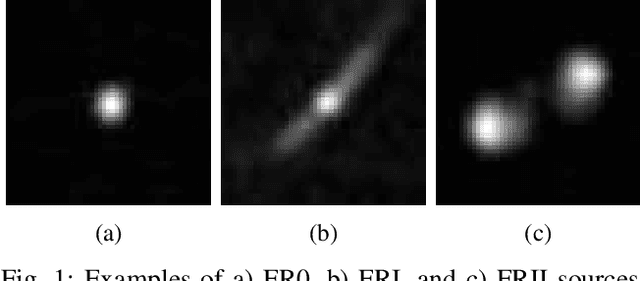

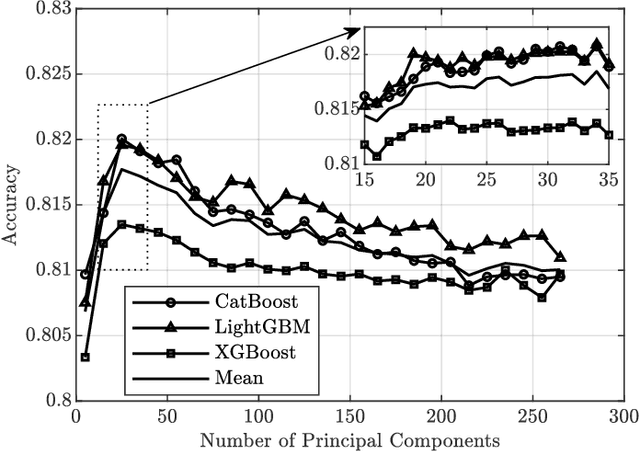
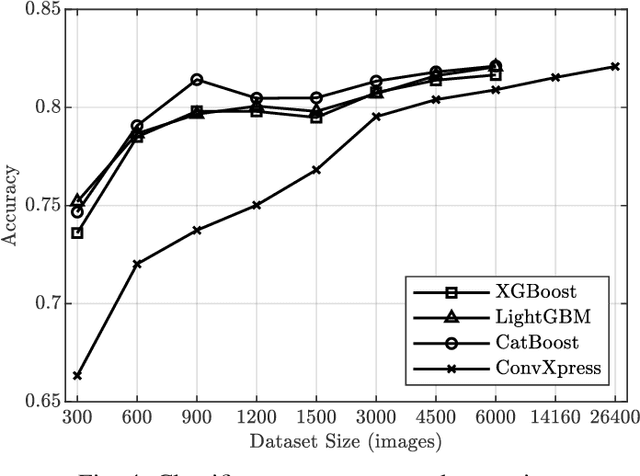
Abstract:The field of radio astronomy is witnessing a boom in the amount of data produced per day due to newly commissioned radio telescopes. One of the most crucial problems in this field is the automatic classification of extragalactic radio sources based on their morphologies. Most recent contributions in the field of morphological classification of extragalactic radio sources have proposed classifiers based on convolutional neural networks. Alternatively, this work proposes gradient boosting machine learning methods accompanied by principal component analysis as data-efficient alternatives to convolutional neural networks. Recent findings have shown the efficacy of gradient boosting methods in outperforming deep learning methods for classification problems with tabular data. The gradient boosting methods considered in this work are based on the XGBoost, LightGBM, and CatBoost implementations. This work also studies the effect of dataset size on classifier performance. A three-class classification problem is considered in this work based on the three main Fanaroff-Riley classes: class 0, class I, and class II, using radio sources from the Best-Heckman sample. All three proposed gradient boosting methods outperformed a state-of-the-art convolutional neural networks-based classifier using less than a quarter of the number of images, with CatBoost having the highest accuracy. This was mainly due to the superior accuracy of gradient boosting methods in classifying Fanaroff-Riley class II sources, with 3--4\% higher recall.
Martian Ionosphere Electron Density Prediction Using Bagged Trees
Nov 03, 2022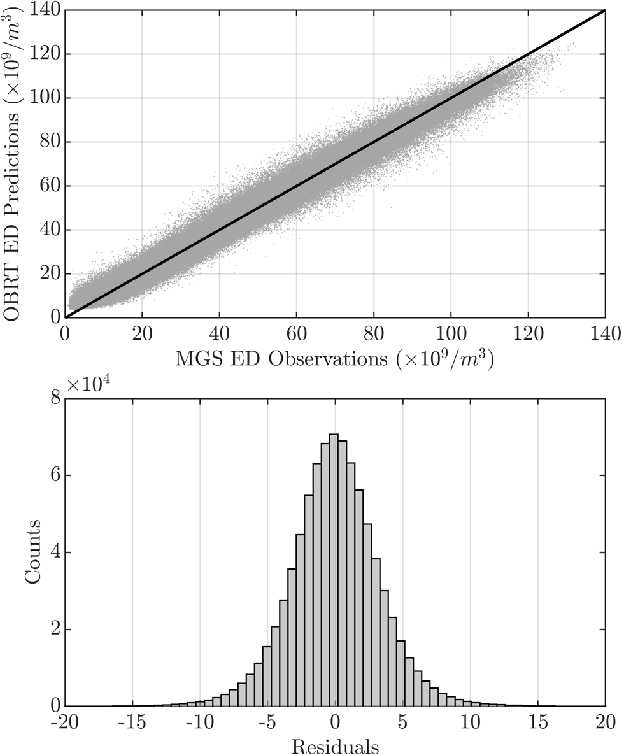
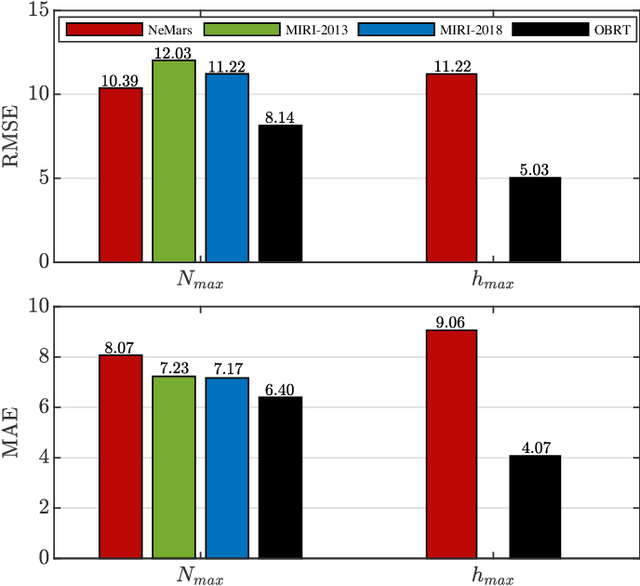
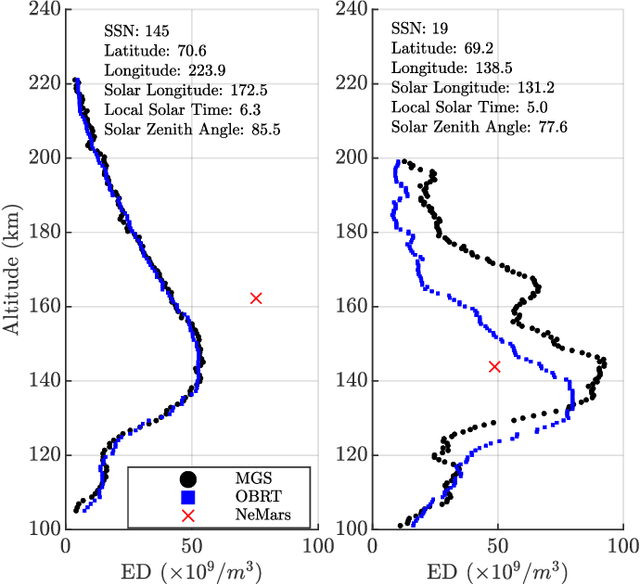
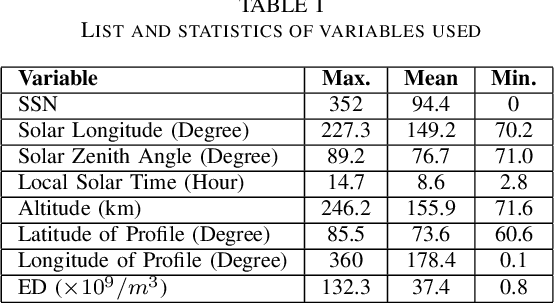
Abstract:The availability of Martian atmospheric data provided by several Martian missions broadened the opportunity to investigate and study the conditions of the Martian ionosphere. As such, ionospheric models play a crucial part in improving our understanding of ionospheric behavior in response to different spatial, temporal, and space weather conditions. This work represents an initial attempt to construct an electron density prediction model of the Martian ionosphere using machine learning. The model targets the ionosphere at solar zenith ranging from 70 to 90 degrees, and as such only utilizes observations from the Mars Global Surveyor mission. The performance of different machine learning methods was compared in terms of root mean square error, coefficient of determination, and mean absolute error. The bagged regression trees method performed best out of all the evaluated methods. Furthermore, the optimized bagged regression trees model outperformed other Martian ionosphere models from the literature (MIRI and NeMars) in finding the peak electron density value, and the peak density height in terms of root-mean-square error and mean absolute error.
Amplitude Scintillation Forecasting Using Bagged Trees
Jul 18, 2022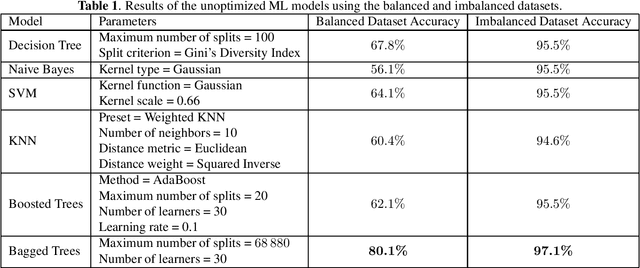

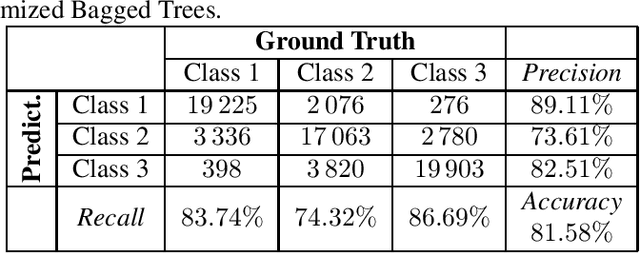
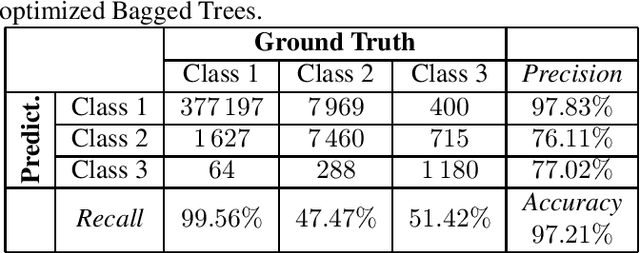
Abstract:Electron density irregularities present within the ionosphere induce significant fluctuations in global navigation satellite system (GNSS) signals. Fluctuations in signal power are referred to as amplitude scintillation and can be monitored through the S4 index. Forecasting the severity of amplitude scintillation based on historical S4 index data is beneficial when real-time data is unavailable. In this work, we study the possibility of using historical data from a single GPS scintillation monitoring receiver to train a machine learning (ML) model to forecast the severity of amplitude scintillation, either weak, moderate, or severe, with respect to temporal and spatial parameters. Six different ML models were evaluated and the bagged trees model was the most accurate among them, achieving a forecasting accuracy of $81\%$ using a balanced dataset, and $97\%$ using an imbalanced dataset.
Empirical evaluation of shallow and deep learning classifiers for Arabic sentiment analysis
Dec 01, 2021
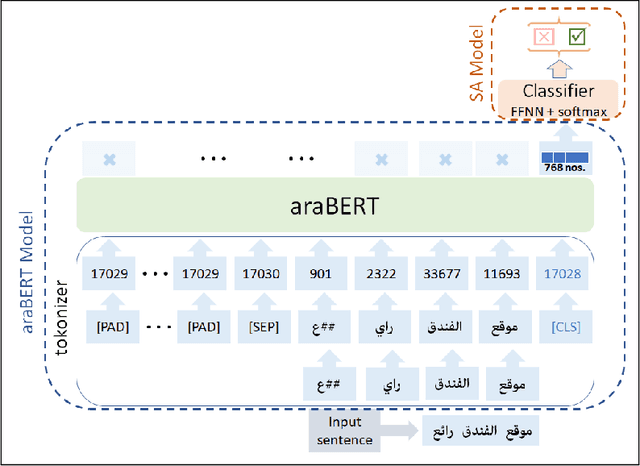


Abstract:This work presents a detailed comparison of the performance of deep learning models such as convolutional neural networks (CNN), long short-term memory (LSTM), gated recurrent units (GRU), their hybrids, and a selection of shallow learning classifiers for sentiment analysis of Arabic reviews. Additionally, the comparison includes state-of-the-art models such as the transformer architecture and the araBERT pre-trained model. The datasets used in this study are multi-dialect Arabic hotel and book review datasets, which are some of the largest publicly available datasets for Arabic reviews. Results showed deep learning outperforming shallow learning for binary and multi-label classification, in contrast with the results of similar work reported in the literature. This discrepancy in outcome was caused by dataset size as we found it to be proportional to the performance of deep learning models. The performance of deep and shallow learning techniques was analyzed in terms of accuracy and F1 score. The best performing shallow learning technique was Random Forest followed by Decision Tree, and AdaBoost. The deep learning models performed similarly using a default embedding layer, while the transformer model performed best when augmented with araBERT.
 Add to Chrome
Add to Chrome Add to Firefox
Add to Firefox Add to Edge
Add to Edge